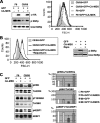Polycystin-1 regulates extracellular signal-regulated kinase-dependent phosphorylation of tuberin to control cell size through mTOR and its downstream effectors S6K and 4EBP1
- PMID: 19255143
- PMCID: PMC2668371
- DOI: 10.1128/MCB.01259-08
Polycystin-1 regulates extracellular signal-regulated kinase-dependent phosphorylation of tuberin to control cell size through mTOR and its downstream effectors S6K and 4EBP1
Abstract
Autosomal dominant polycystic kidney disease (ADPKD) is a common genetic disease characterized by bilateral renal cyst formation. Both hyperproliferation and hypertrophy have been previously observed in ADPKD kidneys. Polycystin-1 (PC-1), a large orphan receptor encoded by the PKD1 gene and mutated in 85% of all cases, is able to inhibit proliferation and apoptosis. Here we show that overexpression of PC-1 in renal epithelial cells inhibits cell growth (size) in a cell cycle-independent manner due to the downregulation of mTOR, S6K1, and 4EBP1. Upregulation of the same pathway leads to increased cell size, as found in mouse embryonic fibroblasts derived from Pkd1-/- mice. We show that PC-1 controls the mTOR pathway in a Tsc2-dependent manner, by inhibiting the extracellular signal-regulated kinase (ERK)-mediated phosphorylation of tuberin in Ser664. We provide a detailed molecular mechanism by which PC-1 can inhibit the mTOR pathway and regulate cell size.
Figures









Similar articles
-
Carboxy terminal tail of polycystin-1 regulates localization of TSC2 to repress mTOR.PLoS One. 2010 Feb 16;5(2):e9239. doi: 10.1371/journal.pone.0009239. PLoS One. 2010. PMID: 20169078 Free PMC article.
-
S6 kinase 1 knockout inhibits uninephrectomy- or diabetes-induced renal hypertrophy.Am J Physiol Renal Physiol. 2009 Sep;297(3):F585-93. doi: 10.1152/ajprenal.00186.2009. Epub 2009 May 27. Am J Physiol Renal Physiol. 2009. PMID: 19474189 Free PMC article.
-
A study of sirolimus and mTOR kinase inhibitor in a hypomorphic Pkd1 mouse model of autosomal dominant polycystic kidney disease.Am J Physiol Renal Physiol. 2019 Jul 1;317(1):F187-F196. doi: 10.1152/ajprenal.00051.2019. Epub 2019 May 1. Am J Physiol Renal Physiol. 2019. PMID: 31042058 Free PMC article.
-
Phosphorylation, protein kinases and ADPKD.Biochim Biophys Acta. 2011 Oct;1812(10):1219-24. doi: 10.1016/j.bbadis.2011.03.001. Epub 2011 Mar 15. Biochim Biophys Acta. 2011. PMID: 21392577 Review.
-
Regulation of mTOR by polycystin-1: is polycystic kidney disease a case of futile repair?Cell Cycle. 2006 Nov 1;5(21):2425-9. doi: 10.4161/cc.5.21.3408. Epub 2006 Sep 13. Cell Cycle. 2006. PMID: 17102641 Review.
Cited by
-
Bending the path to TOR.Nat Cell Biol. 2010 Nov;12(11):1031-3. doi: 10.1038/ncb1110-1031. Nat Cell Biol. 2010. PMID: 21045803
-
Strategies targeting cAMP signaling in the treatment of polycystic kidney disease.J Am Soc Nephrol. 2014 Jan;25(1):18-32. doi: 10.1681/ASN.2013040398. Epub 2013 Dec 12. J Am Soc Nephrol. 2014. PMID: 24335972 Free PMC article. Review.
-
PPAR-gamma agonist ameliorates kidney and liver disease in an orthologous rat model of human autosomal recessive polycystic kidney disease.Am J Physiol Renal Physiol. 2011 Feb;300(2):F465-74. doi: 10.1152/ajprenal.00460.2010. Epub 2010 Dec 8. Am J Physiol Renal Physiol. 2011. PMID: 21147840 Free PMC article.
-
Hyperosmotic stress stimulates autophagy via polycystin-2.Oncotarget. 2017 Jul 5;8(34):55984-55997. doi: 10.18632/oncotarget.18995. eCollection 2017 Aug 22. Oncotarget. 2017. PMID: 28915568 Free PMC article.
-
Bisphenol A Modulates Autophagy and Exacerbates Chronic Kidney Damage in Mice.Int J Mol Sci. 2021 Jul 3;22(13):7189. doi: 10.3390/ijms22137189. Int J Mol Sci. 2021. PMID: 34281243 Free PMC article.
References
-
- Bhunia, A. K., K. Piontek, A. Boletta, L. Liu, F. Qian, P. N. Xu, F. J. Germino, and G. G. Germino. 2002. PKD1 induces p21(waf1) and regulation of the cell cycle via direct activation of the JAK-STAT signaling pathway in a process requiring PKD2. Cell 109157-168. - PubMed
-
- Boletta, A., F. Qian, L. F. Onuchic, A. K. Bhunia, B. Phakdeekitcharoen, K. Hanaoka, W. Guggino, L. Monaco, and G. G. Germino. 2000. Polycystin-1, the gene product of PKD1, induces resistance to apoptosis and spontaneous tubulogenesis in MDCK cells. Mol. Cell 61267-1273. - PubMed
Publication types
MeSH terms
Substances
Grants and funding
LinkOut - more resources
Full Text Sources
Other Literature Sources
Molecular Biology Databases
Research Materials
Miscellaneous
